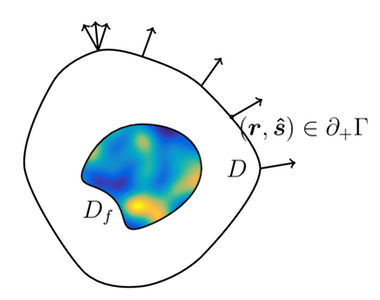Image Science with Particle Processing Detectors
In recent years, emission imaging systems have begun to incorporate a new detector design based on on-the-fly event attribute estimation. These new detectors - called particle processing detectors - lead to interesting new mathematical models for imaging systems. The goal is to quantify the performance of such detectors using the theory of inverse problems and statistical decision theory.

\( \newcommand{\r}{\boldsymbol{r}} \newcommand{\e}{\mathcal{E}} \newcommand{\s}{\hat{\boldsymbol{s}}} \newcommand{\K}{\mathcal{K}} \) To be more precise, I work with imaging system models that are decomposed into two operators, a propagation operator \(\mathcal{P}\) and a detection operator \(\mathcal{D}\). The propogation operator models the physics of the energy used, so in my case (I work mostly in emission imaging) it’s the solution operator to a Radiative Transfer Equation (RTE):
(A figure describing optical phase space)
This equation models the propagation of high-frequency light from visible up to X-Ray, and even particles like \(\alpha\)s and \(\beta\)s, in biological tissue. Solving this equation results in the \(\mathcal{P}\) operator:
This
Detector Modeling
###